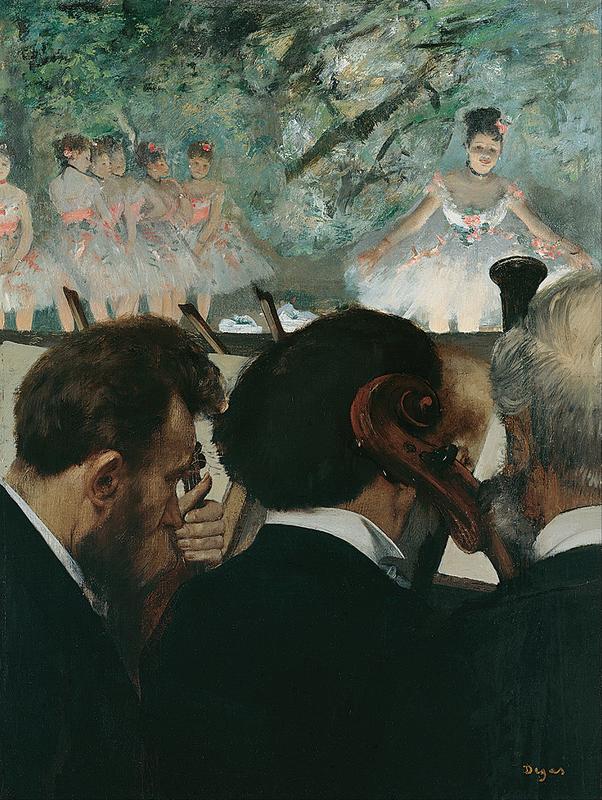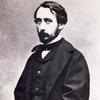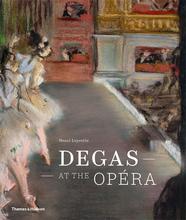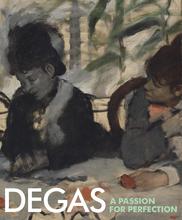More about Orchestra Musicians
- All
- Info
- Shop

Sr. Contributor
Edgar Degas once traded to get Orchestra Musicians back from its new owner to implement some edits that had been nagging at him.
This piece wasn’t the only one he traded for, however. Orchestra Musicians and several others were traded for Degas to tweak. He gave four larger paintings he thought more elaborate in exchange. What was bugging him so much? Well, originally this piece had an orientation much similar to a work that Degas completed shortly before it: The Orchestra at the Opera. In that painting, the ballerinas are cut off at the neck and take up much less space than the orchestra pit. Degas decided he wanted to shift this piece to equally divide the space between the pit and the stage.
A bit of franken-canvasing later, the sides were slimmed down and the top was extended. Degas rendered the ballerinas in full and moved onto fussing with other works. Perfectionism and indecision weren’t unusual for Degas. One art critic early in his career likened him to a modern day Raphael, just one who hadn’t finished anything.
Though we only see the musicians in the piece from behind, it’s possible the middle figure is meant to be Degas’ friend Désiré Dihau. Degas' earlier painting The Orchestra at the Opera was done as a portrait for Dihau, who was a well-regarded bassoonist, and also included several of Degas’ non-musician friends to fill out a lively fantasy band. Though Degas largely obscured it when he sliced up the canvas of Orchestra Musicians (specifically by adding in the man with the gray hair on the right), the man in the center is holding a bassoon.
Degas’ parents were fans of his friendship with Dihau, thanking Dihau for being the reason Degas finally finished “a real painting.” Originally Degas had been fussing with The Orchestra at the Opera too, unsatisfied with it. Dihau snatched it away for an exhibition so he’d leave it be.
This pair of paintings kicked off something of a series for Degas. Nowadays, his numerous depictions of ballerinas are some of what he’s best known for. These were the first pieces where he flirted with expressing his love for the theatre from viewpoints that hadn’t yet been explored in the audience. In Orchestra Musicians, we’re watching the dancers from what would have been considered the best seats in the house. Front row, squished right behind the tall musicians and large instruments. Theoretically ideal, unless you’re on the shorter side.
Sources
- Boggs, Jean Sutherland. Essay. In Degas: An Exhibition Held at the Galeries Nationales Du Grand Palais, Paris, 9 February-16 May 1988, National Gallery of Canada, Ottawa, 16 June-28 August 1988, the Metropolitan Museum of Art, New York, 27 September 1988-8 January 1989, 164. Metropolitan Museum of Art, 1988.
- Brodskaya, Nathalia. Essay. In Edgar Degas, 15–16. Parkstone International, 2012.
- Growe, Bernd. Essay. In Edgar Degas 1834 - 1917, 32–36. Köln: Taschen, 1991.
- “Orchestra Musicians.” Städel Digital Collection. Städel Museum. Accessed June 18, 2022. https://sammlung.staedelmuseum.de/en/work/orchestra-musicians.
- “Research & Conservation Degas - Orchestra Musicians.” Städel Museum. Accessed June 18, 2022. https://www.staedelmuseum.de/en/research-conservation-degas-orchestra- musicians.
- Tinterow, Gary, and Henri Loyrette. Essay. In Origins of Impressionism, 225–29. New York: Metropolitan Museum of Art, 1994.













